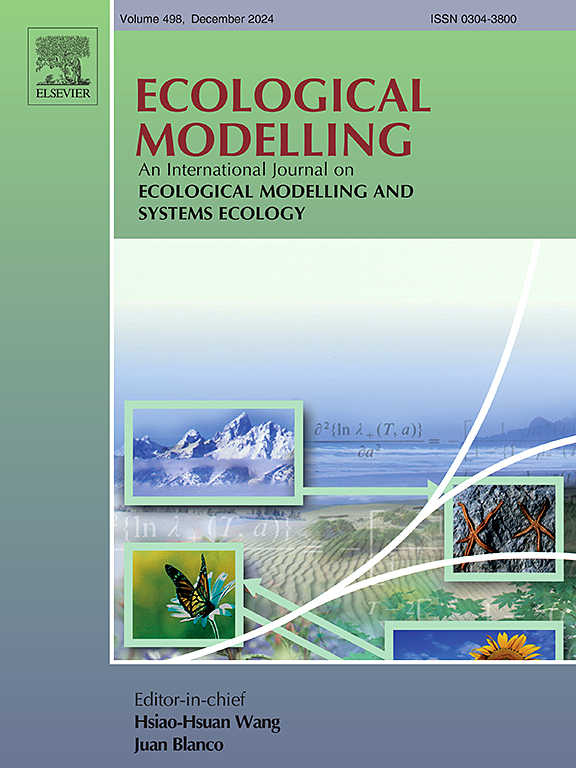切萨皮克湾弗吉尼亚中半岛生物栖息地变化的经济影响
IF 2.6
3区 环境科学与生态学
Q2 ECOLOGY
引用次数: 0
摘要
生物栖息地支持着重要的生态和商业物种,但也受到人为压力因素(包括气候变化)的威胁。切萨皮克湾的两种生物栖息地--东牡蛎(Crassostrea virginica)和鳗草(Zostera marina)--的数量与历史水平相比已经枯竭,但最近的牡蛎恢复工作创造了新的礁石栖息地,并增强了现有的牡蛎礁。其他动物(如具有重要商业价值的鱼类和无脊椎动物)食用与这些生物栖息地相关的生物,这表明依赖于商业捕鱼业的区域经济可能会受到生物栖息地覆盖率变化的影响。我们为弗吉尼亚中南半岛两条经过牡蛎修复的河流建立了生态系统模型,并进行了模拟,以估计生物栖息地的变化可能对商业渔业收成产生的潜在影响。此外,还对商业渔民进行了访谈,以记录将生态模型估计值与通过 IMPLAN 估算这些变化对区域经济影响的经济投入产出模型联系起来所需的支出。据预测,牡蛎和 Eelgrass 数量的增加将提高商业渔业数量,进而提高渔获量,而生物栖息地数量的减少将对渔获量产生负面影响。上岸价值趋势背后的驱动因素是利润丰厚的蓝蟹(Callinectes sapidus)渔业的变化。水上居民的主要支出是修理/维护、燃料和鱼饵,但每年超过 37% 的收入是作为业主和船员的收入。据预测,在 20 年模拟期结束时,仅牡蛎礁恢复一项就可将商业捕鱼业的区域经济影响提高 110 万美元/年,并增加 12 个全职工作岗位。牡蛎恢复与 Eelgrass 的持续衰退相结合,对区域经济影响的增加可忽略不计(1.5 亿美元/年-1)。在没有牡蛎影响的情况下,将黄颡草恢复到当前的管理目标,预计对区域经济的影响将提高到 1,680 万美元/年-1 和 152 个全职工作岗位,相对于当前水平,黄颡草数量的较小增长仍将对区域经济产生积极影响。据预测,牡蛎和黄颡鱼的联合恢复将在最大程度上提高经济影响,而黄颡鱼的持续减少可能会将这些效益降至最低。本文章由计算机程序翻译,如有差异,请以英文原文为准。
The economic impacts of living habitat changes in the Virginia Middle Peninsula, Chesapeake Bay
Living habitats support ecologically and commercially important species but are threatened by anthropogenic stressors, including climate change. The populations of two living habitats in the Chesapeake Bay, Eastern Oyster (Crassostrea virginica) and Eelgrass (Zostera marina), are depleted compared to historical levels, but recent Oyster restoration efforts have created new reef habitat and enhanced existing Oyster reefs. Other animals (e.g., commercially important fish and invertebrates) consume organisms that associate with these living habitats, suggesting the regional economies that rely on the commercial fishing industry may be impacted by changes in living habitat coverage. Ecosystem models were developed for two rivers that have undergone Oyster restoration in the Virginia Middle Peninsula, and simulations were conducted to estimate the potential influence that changes to living habitats may have on commercial fisheries harvests. Additionally, commercial fishers were interviewed to document expenditures needed to link ecological model estimates to an economic input-output model via IMPLAN that estimated the regional economic impacts of these changes. Increases to Oyster and Eelgrass populations are predicted to enhance commercial fisheries populations and in turn, harvests, while decreases to living habitats are predicted to have negative effect on fisheries harvests. The driving factor behind landed value trends is changes with the lucrative Blue Crab (Callinectes sapidus) fishery. The primary expenses of watermen are repairs/maintenance, fuel, and bait, but greater than 37 % of the annual revenue is retained as proprietor and crew income. Oyster reef restoration alone is predicted to increase the regional economic impact of the commercial fishing industry by $1.1 M yr-1 and support 12 more full-time jobs at the end of a 20-year simulation. Oyster restoration in combination with a continued decline of Eelgrass led to a negligible increase (∼$150 K yr-1) in the regional economic impact. Eelgrass restoration to the current management goal without the influence of Oyster restoration is anticipated to elevate the regional economic impact to $16.8 M yr-1 and 152 full-time jobs, and smaller increases to the Eelgrass population, relative to current levels, will still have a positive impact on the regional economy. Combined Oyster and Eelgrass restoration are predicted to enhance economic impacts to the greatest extent, while continued Eelgrass decline is likely to minimize these benefits.
求助全文
通过发布文献求助,成功后即可免费获取论文全文。
去求助
来源期刊

Ecological Modelling
环境科学-生态学
CiteScore
5.60
自引率
6.50%
发文量
259
审稿时长
69 days
期刊介绍:
The journal is concerned with the use of mathematical models and systems analysis for the description of ecological processes and for the sustainable management of resources. Human activity and well-being are dependent on and integrated with the functioning of ecosystems and the services they provide. We aim to understand these basic ecosystem functions using mathematical and conceptual modelling, systems analysis, thermodynamics, computer simulations, and ecological theory. This leads to a preference for process-based models embedded in theory with explicit causative agents as opposed to strictly statistical or correlative descriptions. These modelling methods can be applied to a wide spectrum of issues ranging from basic ecology to human ecology to socio-ecological systems. The journal welcomes research articles, short communications, review articles, letters to the editor, book reviews, and other communications. The journal also supports the activities of the [International Society of Ecological Modelling (ISEM)](http://www.isemna.org/).
 求助内容:
求助内容: 应助结果提醒方式:
应助结果提醒方式:


